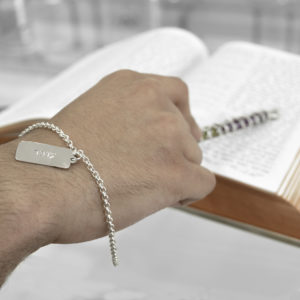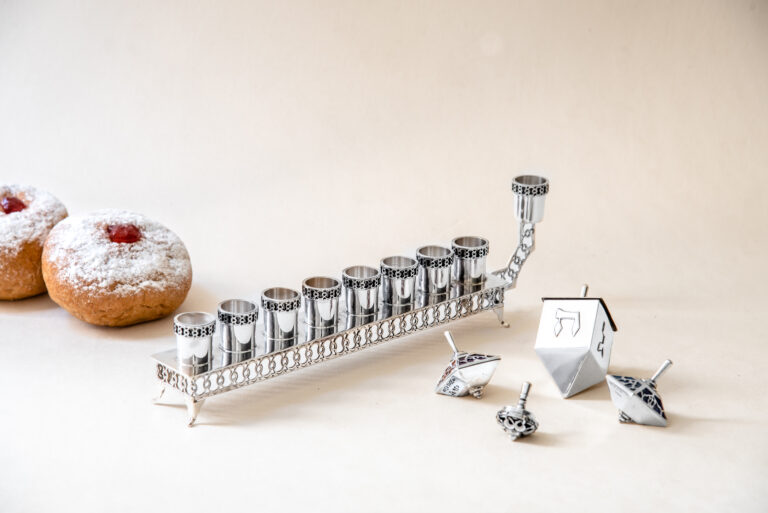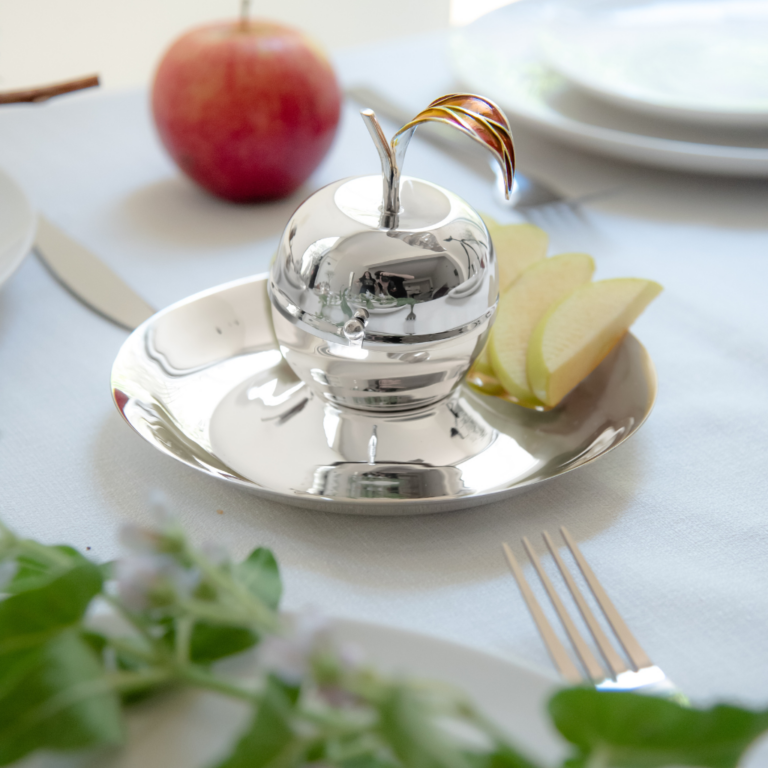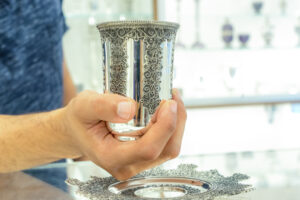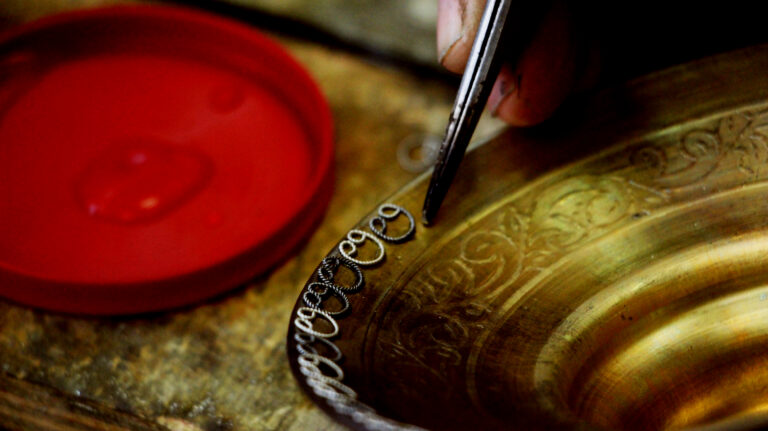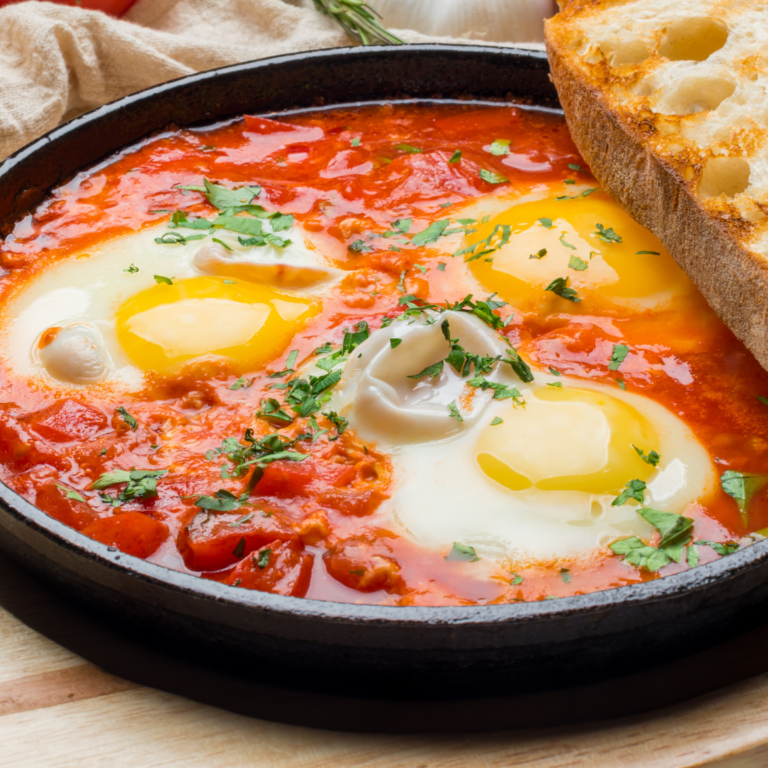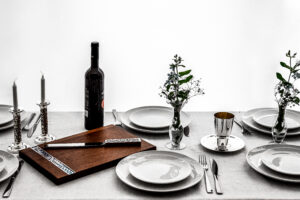Everything you need to know about the Jewish New Year
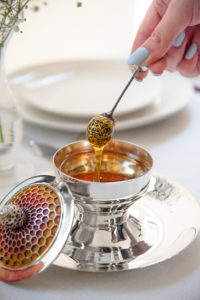
Rosh HaShanah is the Jewish New Year and it begins this year at sunset on Sunday September 25th. Rosh HaShanah 2022 will hopefully be a special celebration. We seem to finally be out of lockdown and families and close friends can get together without restrictions. If you’re planning a Rosh HaShanah dinner, or just want to learn more about this important Jewish holiday, we’ve got the full info and some great holiday tips.
What is Rosh HaShanah?
2022/5783
Rosh HaShanah literally means ‘head of the year’. It’s written רֹאשׁ הַשָּׁנָה in Hebrew and is the Jewish New Year. Rosh HaShanah is the first of the High Holy Days and falls 10 days before Yom Kippur. For most US Jews and secular Israelis Rosh HaShanah is simply a time to get together and enjoy a good dinner.
The New Year is a two day public holiday in Israel and brings a welcome break from work. The timing of Rosh HaShanah in 2022 means that with the preceding weekend, most Israelis will get a solid five day break. Plenty of people will be taking the opportunity to fly abroad for an early autumn vacation.
How to Celebrate Rosh HaShanah?
Most people in the US and Europe celebrate Rosh HaShanah with a family dinner. Unlike Passover and Hanukkah, Rosh HaShanah doesn’t really coincide with any Christian holidays or major public holidays. If you want time off for the Jewish New Year, you’ll probably have to use up personal vacation days. Most Jews outside Israel only manage a basic celebration, especially if the holiday falls mid-week. That’s a shame, because Rosh HaShanah can be a lot of fun!
A typical Israeli Rosh HaShanah celebration includes a big family get together and a New Year dinner with traditional Rosh HaShanah foods. People also exchange gifts – even just a bottle of wine, or a gift of seasonal fruit or honey. Judaica gifts like hand made honey dishes and wine accessories (wine fountains, wine holders, and Kiddush cups) are also popular.
There’s a growing trend in Israel to celebrate Rosh HaShanah with an outdoor meal or a big picnic. Some families love to travel to the beautiful areas of the Golan or Galil and take zimmers (holiday chalets) for a long weekend. Rosh HaShanah in Israel usually arrives with the more gentle autumn weather and is a wonderful time to be outdoors. If you live in a warmer area of the US, consider celebrating Rosh HaShanah with a family picnic or a trip to a vacation cabin.
How Do I Prepare a Rosh HaShanah Dinner?
A traditional Rosh HaShanah is based around seasonal foods that are harvested in the late summer and early autumn. The deep origin of the Jewish New Year is in the ancient agricultural cycles of the prehistoric Middle East. Our early ancestors lived close to the land and depended on their fields, orchards and vineyards for survival. Their lives revolved around seasonal planting and harvesting and their holidays marked key events in the agricultural cycles.
When the Zionists pioneered Israeli agriculture, particularly through the Kibbutz movement, Rosh HaShanah took on a special significance as a harvest festival. Israelis are still proud of their agricultural achievement and the amazing fruit and vegetables that are harvested all year round.
Many families hold a Rosh HaShanah Seder. This is similar to the Passover Seder, but the rituals are far shorter and less demanding. The main similarity is the consumption of symbolic foods (sinamim). The tradition of holding a Rosh HaShanah Seder is believed to be at least 2,000 years old. If you do have a Rosh HaShanah dinner with symbolic foods and blessings this year, you’ll be continuing an ancient Jewish tradition.
10 popular Rosh HaShanah foods include:
- Honey
- Honey Cakes
- Tzimmes
- Leaks
- Pumpkins
- Beans
- Beets
- Apples
- Pomegranates
- Dates
There’s no religious obligation to serve any of these foods at your Rosh HaShanah dinner. If you can’t find dates or pomegranates in the local stores, you don’t have to drive around town in search of them. You can use any local produce that’s appetizing and in season. Jews adapted and made do throughout history. It’s the spirit of your Rosh HaShanah Seder that’s important – not the fine details!
How do I Prepare Tzimmes?
Tzimmes is a classic Jewish dish that’s often served at holiday meals and especially at Rosh HaShanah. Like every Jewish dish, there are dozens of variations and different recipes. Some have been in families for generations and everybody has their own favorite additions and improvements.
The basic tzimmes dish usually includes sweet potato, carrots, and prunes or dates, baked in the oven. The veggies and fruit are cooked in a sauce that contains honey, butter, and fruit juice (usually orange) and can be flavored with cinnamon, brown sugar, and any other spices that you like.
Tzimmes is a sweet dish that balances the meat course and adds some wonderful flavors to any meal. Two traditional foods that used to be served at Rosh HaShanah Seders were lamb’s heads and fish heads (poor communities couldn’t afford to waste anything). Modern tastes have moved on a bit since those days, but if you are serving baked fish, or gefilte fisch, tzimmes is an excellent side dish.
What Gifts Should I Buy for Rosh HaShanah?
There’s no obligation to buy gifts for Rosh HaShanah, but it’s popular to celebrate the Jewish New Year with presents and greeting cards. If you’re going to a Seder, it’s definitely polite to bring a bottle of good wine, or to offer to bake a lekach (honey cake) or contribute another dish. If you want to give a bigger Rosh HaShanah gift, the most popular choices are either an Item of handmade Judaica, or an item of Jewish art.
5 Most Popular Rosh HaShanah Gifts
The beauty of Rosh HaShanah Judaica gifts is that most of them can be used all year round. If you present your Seder host with a handmade silver honey dish, it can be used at every Shabat dinner and family meal. Even when you’re not using it, a finely crafted item of Judaica is a wonderful ornament. Both traditional silver filigree and modern anodized aluminum styles look amazing arranged on a sideboard or in a dresser display.
- Handmade Honey Pots
- Ornamental Honey Spoons
- Rosh HaShanah Plates
- Challah Boards and Knives
- Wine Fountains
Another popular Rosh HaShanah gift is any item of Judaica that is decorated with apple and pomegranate motifs. Silver trays, candlesticks and Kiddush cups with natural decorations are ideal for Jewish New Year celebrations.
Rosh HaShanah Honey Dishes
Honey was incredibly important to our early Jewish ancestors. Bees were essential for pollinating orchards and other crops. In an age without processed sugar, honey was one of the few sources of sweetness and was highly valued. It’s also been a part of folk medicine and was used to heal wounds and treat infections.
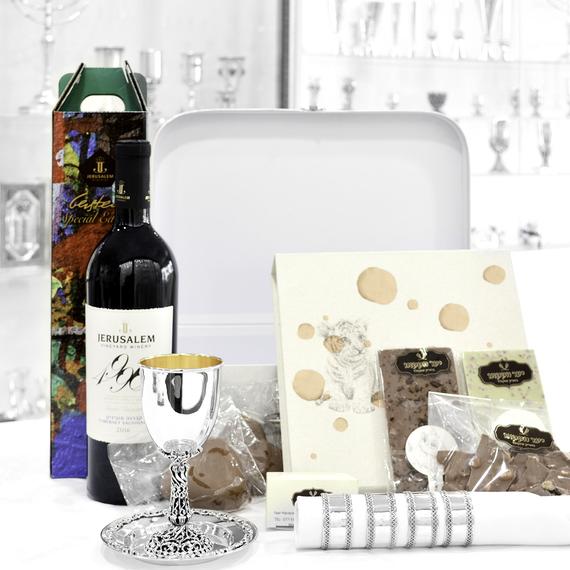 Even today honey is valued as a luxury item and is the preferred sweetener for many health conscious people. The Israeli beekeeping industry is a key part of local agriculture and Israeli honey is always included in gourmet Mishloach manot baskets for Purim.
Even today honey is valued as a luxury item and is the preferred sweetener for many health conscious people. The Israeli beekeeping industry is a key part of local agriculture and Israeli honey is always included in gourmet Mishloach manot baskets for Purim.
Honey dishes are a classic Rosh HaShanah gift, and are also popular small wedding gifts and housewarming gifts. They’re one of those special items that can really add the perfect finishing touch to your dinner table. Even if you’re not sitting down to a meal, a silver honey dish looks amazing when you serve guests with tea and coffee, or snacks.
Traditional Handmade Silver Honey Dishes
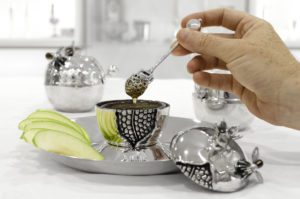
Today, handmade Rosh HaShanah honey dishes fall into two broad styles – traditional and contemporary. Traditional honey pots are crafted from 925 sterling silver and often feature intricate designs and ornamentation. Some of the finest handmade honey dishes are decorated with intricate silver filigree work.
To our entire collection of 925 Sterling Silver honey dishes Click here
This kind of silversmithing takes years of training and practice to produce. The exquisite Yemenite filigree work that master jewelers like Avi Nadav use, is the product of generations of family craftsmanship. Artists like Avi Nadav don’t create ornaments. A highly polished, handmade silver honey pot is also a functional dish that’s designed for daily use.
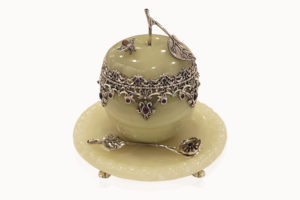
As well as Yemenite style silver filigree, handmade Rosh HaShanah honey dishes are typically decorated with natural motifs. These include 925 sterling silver solder designs such as vine leaves, apples and pomegranates – and of course – honey bees and beehives! One of the most luxurious traditional designs uses Israeli Onyx with silver filigree.
Designer Handmade Honey Dishes
If you love the functional beauty of art deco, bold minimalist designs, or exciting experimental materials, you’ll love modern style Rosh HaShanah honey dishes. One of the most popular materials is anodized aluminum. It’s super tough, looks amazing, and comes in all kinds of bright colors.
To our entire collection of Anodized aluminum honey dishes Click here
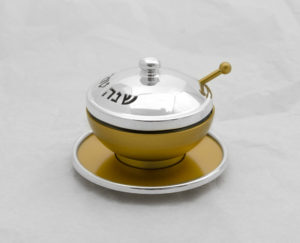
Even the most modern handmade designs can still express the deeper, ancient traditions. A designer aluminum honey pot can easily be decorated with a traditional blessing like Shana Tovah – שנה טובה- Hebrew for Happy New Year. If anything, modern materials and design techniques are even more adaptable than old fashioned silversmithing. The final quality of modern Judaica is superb.
Rosh HaShanah Plates
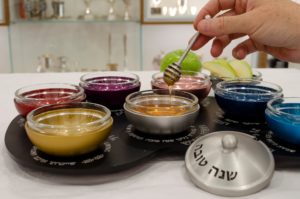
Rosh HaShanah Seder plates are a recent innovation based on traditional Passover Seder plates. The modern designs are shaped like artists palettes and contain inserts for dishes. The idea is that you can offer guests a taste of symbolic Rosh HaShanah foods, without cluttering your dining table. The Rosh HaShanah plates designed by Nadav Art are coated with a layer of teflon for practicality.
The sleek design and ultra modern anodized aluminum plate and dishes look amazing. The aluminum is available in a dozen different colors and is decorated with traditional Jewish New Year blessings and greetings. If you’re struggling to find an original and special gift for Rosh HaShanah, a wedding present or housewarming gift, a Rosh HaShanah plate can be a great choice.
Challah Boards and Knives
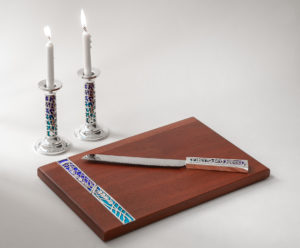
Challah bread is an important part of any Rosh HaShanah dinner and a decorated challah boards is a superb gift. It’s a special item that shows a lot of thought and consideration, but is also affordable, and not too ostentatious. The advantage of choosing a challah board and knife as a Rosh HaShanah gift is that they’ll get regular use all year round. This is a practical item that will be welcome in any Jewish home.
Arguably, the most beautiful challah boards are made from maple or mahogany and decorated with a band of silver filigree and colored enamel inlay. They are simple, elegant, and entirely functional. The best Rosh HaShanah gift solution is actually a Shabbat Set that includes a handmade challah board, knife and ornamental silver candlesticks.
Wine Fountains for Rosh HaShanah
Rosh HaShanah is a great opportunity to sit back and enjoy a good Israeli wine. Wine isn’t just part of the Seder ritual. With the warm, sunny afternoons and refreshingly cooler evenings, it can be a real pleasure to sit on the balcony, or in the garden with a glass of wine. If you’re having a full family dinner or entertaining guests, a wine fountain is a real dinner table attraction.
A wine fountain is basically an ornamental stand, with a series of cleverly concealed pipes. You can slowly pour a bottle of wine into a top Kiddush style goblet and the wine gently trickles down into 8 or 10 decorative wine cups. The wine fountain is designed to allow each guest to take their filled cup with no risk of any spillage.
A handmade wine fountain from Jerusalem is a beautiful item that will come out whenever you serve wine at your dinner table. It sounds extravagant, but is very practical and is a lot of fun. If you just use it for non-alcoholic Kiddush grape juice, the kids and grandkids will love it too.
Rosh HaShanah 2022 will hopefully be a great New Year holiday. If you’re visiting Israel you’ll be in for a real 5 day autumn break (most people will take a week off) and you’ll get a chance to sample the very best Israeli food, wine and warm hospitality!
To view and see all our Rosh Hashanah products please click here
